The business of gay pride

Simply sign up to the Life & Arts myFT Digest -- delivered directly to your inbox.
One June evening, on a broad pier jutting out into the Hudson river from the west side of Manhattan, New York, three words hang briefly in the sticky summer air: “Merry gay Christmas!”
The shout, emitted by a girl in knee-length rainbow socks and matching headband, is swiftly drowned out — first by the growl of Beyoncé’s “Formation” blaring through an enormous festival-style sound system; second, by the collective whoop of the thousands of women assembled beneath it. The pier is lined with promotional marquees: in a Delta Air Lines tent stamped with the tagline “Love, having no geography, knows no boundaries”, couples are invited to sit for digital caricatures sketched by artists on iPads; outside, a flight attendant in uniform pushes a trolley through the crowd dispensing flashing party wristbands.
Next door, at T-Mobile, tired partygoers relax on white pouffes under the watch of a fuchsia unicorn. The pink paraphernalia that surrounds it bears the slogan: “Mobilize for equality.”
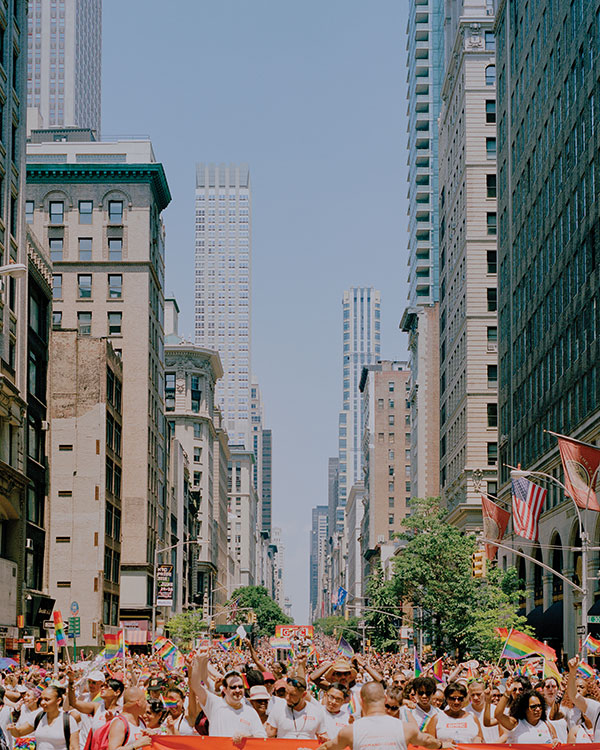
“Gay Christmas”, more formally known as Pride, is held in New York every June. InterPride, which represents Pride organisers around the world, estimates that New York’s is one of the three biggest such events, along with those in Madrid, held each July, and São Paulo in May. This year, NYC Pride included not only the march for which the movement is famous — during which two million spectators line the streets of Manhattan to cheer the passing floats of big brands and non-profit organisations — but also the party on the pier (a woman’s event called Teaze), a VIP rooftop party and, at the start of the week, a Pride Luminaries Brunch, a $50-a-ticket event serving canapés including cubes of French toast and pieces of bacon, held in clothes pegs suspended along a string.
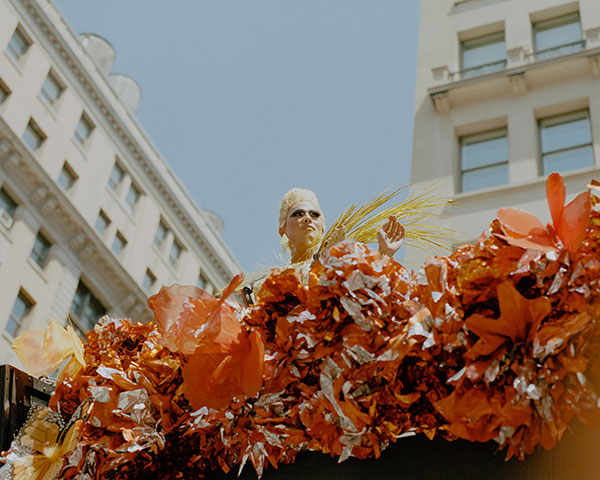
The man responsible for New York’s week-long “event series”, as he puts it, is Chris Frederick, a friendly, articulate 33-year-old with a background in events management. Since he became managing director in 2009, NYC Pride has grown “pretty dramatically”, he tells me when we meet at the organisation’s small basement offices in the West Village, where he sits at a desk with a plaque bearing the words: “Get it, girl.” The event’s budget has almost trebled in that time. This year’s total is an estimated $2.4m; about half comes from sponsorship, which has increased by a factor of 10 over the course of his tenure; the rest comes from ticket sales, fundraising events and float registration fees. Over the same period, the number of people attending the march has grown by a third. (The make-up of the crowd has changed too: a survey undertaken by NYC Pride in 2014 found that more than a quarter of people at the march identified as straight, a figure Frederick calls “kind of mind-bogglingly” high.)

The result is an event that has strayed far from its roots. What was once a political protest has, over half a century, become a boozy, bacchanalian celebration. In an era that increasingly celebrates gender fluidity and sexual liberation, Pride reflects the new freedoms of a once-maligned community that has found itself suddenly embraced. But for many, the movement is in crisis. They believe that, under the weight of commercialisation, Pride has lost sight of its identity — and of the many challenges that the gay community has still to overcome. The outsize influence of brands is “classic pinkwashing”, says Dan Glass, a prominent leftwing LGBT activist in the UK. Last summer, he was part of a group who bore a black coffin on their shoulders along the parade route at Pride in London, symbolising what they, and others, perceive to be the death of the movement. “I love Pride, I really do, but it’s been sold off to the highest bidder,” he says.
. . .

The global Pride movement began on June 28 1969, about a mile uptown from the Teaze pier, when police raided the Stonewall Inn, a gay bar on Christopher Street in the West Village, and provoked a riot among its patrons that lasted for two days. “Gay power! Isn’t that great!” remarked the Beat poet Allen Ginsberg, who lived nearby, after hearing about the commotion. “It’s about time we did something to assert ourselves.”
The annual marches and events — mainly small, commemorative LGBT-rights protests — that took place in the first few years following the riot would be almost unrecognisable to modern Pride supporters. The Reverend Troy Perry, one of the organisers of the first Pride parade in Los Angeles in 1970, has said that when he requested a permit for the event, the local police chief told him it “would be the same as giving a permit to a group of thieves and robbers”. This year in New York, by contrast, an NYPD police vehicle, painted with rainbow stripes and bearing a sign reading “NYPD out and proud”, was part of the parade.
At the start of this year’s march, between police barriers, drag queens and assorted celebrities and politicians (including Democratic presidential candidate Hillary Clinton), I find Sue Doster, a warm, bushy-haired volunteer who has been on the board of NYC Pride on and off since 1990. Her role today is “strategic planning director”, and she surveys the screaming millions before her with a demeanour somewhere between Mary Poppins and a military leader. “Controlled chaos!” she shouts over the racket. “That’s the best we can hope for!”

. . .
New York’s Pride is at the forefront of a phenomenon that is proliferating around the world. “The pride movement has grown drastically in the past 10 years,” says Frank van Dalen, vice-president of InterPride. The organisation is in the process of compiling a complete record of all the events in the world; so far it has identified 944.
Among the newest Prides, according to Van Dalen, are those launched in traditionally homophobic countries such as Rwanda, in 2014, and Jamaica, in 2015. Meanwhile, those already in existence are growing rapidly, even in more politically conservative areas. Matt Comer, a board member of Charlotte Pride, North Carolina, the state that in March this year passed the infamous HB2 “bathroom bill” (an act that, among other things, eliminates anti-discrimination protections for all LGBT people and legislates that individuals may only use bathrooms that correspond to the sex they were assigned at birth), describes the growth of their event in recent years as “phenomenal”. He estimates that attendance has increased tenfold to 120,000 people between 2010 and 2015.
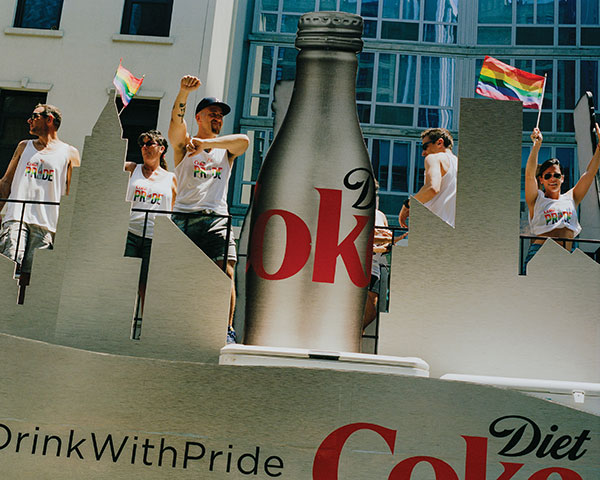
If brands were a big feature of the Teaze party, at the main New York march they threaten to be the main attraction. An enormous silver Diet Coke float rolls down Fifth Avenue blaring out Shania Twain’s “Man! I Feel Like a Woman!”, while cast members from Orange is the New Black, the popular TV series about inmates at a women’s prison, wave regally from the deck of a giant orange Netflix float. At the far end of the route, an enormous billboard for Google’s Android phone operating systems, a mosaic of rainbow-coloured phone screens, towers over the Stonewall Inn: “Be together, not the same.”
Corporate sponsorship of the world’s bigger Prides is not new. At the archive of the Lesbian, Gay, Bisexual & Transgender Community Center in the West Village, there are old programmes from past New York events: up until the early 1990s, they were populated almost entirely with adverts for adult video stores and Aids medications. But in 1996 Miller Lite beer came on board as a major sponsor. Over the past decade, there has been a significant upswing in businesses targeting these events — and the gay community in general.

“Companies are becoming much more comfortable with being a part of Pride celebrations,” says Frederick. His previous experience in events marketing has to an extent facilitated this: according to Sue Doster, the Pride organisation has benefited from his ability to build lasting relationships with brands. “That was his charge,” she says: “‘Bring in the sponsors.’” This year, 16 Global Fortune 500 corporations, including Walmart, Delta, AXA, Netflix, Bud Light, Unilever, BNP Paribas, Nissan and Disney, sponsored the New York event, a number that has almost doubled since 2012. T-Mobile was this year’s presenting sponsor, the top level of corporate partnership, which Frederick says usually costs about $175,000. London’s Pride, though half the size of New York’s, has experienced similar growth in the past decade: its sponsorship revenue, which this year stood at £400,000, has grown 250 per cent since 2013.

The influx of funding mirrors a broader shift in the advertising industry; companies that were once reluctant to market to gay consumers now target them with vigour. One of the first gay-oriented adverts was a VW Golf commercial from 1997 titled “Sunny Afternoon”, featuring two men, who may or may not be a couple. (It debuted during the famous coming-out episode of the sitcom Ellen.) Nearly two decades later, in January 2015, the jeweller Tiffany & Co featured a gay couple in an ad for engagement rings for the first time in its 178-year history. In June, Bud Light ran a TV ad in which the comedians Seth Rogen and Amy Schumer are guests at a gay wedding — “Bud Light proudly supports everyone’s right to marry whoever they want,” says Rogen, before the pair toast the grooms.
“Brand activations” at Pride events have also become increasingly sophisticated. In July 2014, Burger King and the advertising agency David launched a product called the “Proud Whopper” during San Francisco Pride. The only difference from its regular burgers was its rainbow wrapping, which opened to reveal the slogan: “We’re all the same inside.” (After eating the Whopper, a girl interviewed for the agency’s promotional video says: “A burger has never made me cry before.”) At this year’s NYC Pride, in a nod to North Carolina’s “bathroom bill”, there was a MasterCard-sponsored toilet that could be used by anyone applying their hands to a heart-shaped pulse sensor, the idea being that anyone with a heartbeat could use it. “This restroom accepts all humans,” read the tagline.
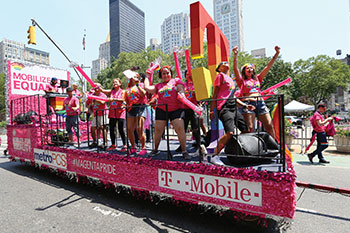
The appeal of the gay community to brands is multifaceted. Its combined global spending power is estimated at $3.7tn a year, according to a 2015 report by LGBT Capital, a corporate advisory and investment management company focused on the LGBT consumer market. Perceived traits such as style-consciousness, the early adoption of new products, and a higher-than-average disposable income make gay consumers a profitable target demographic, says Daphne Kasriel-Alexander, a consumer trends consultant at Euromonitor.
Brands are also increasingly recognising the cachet that comes with aligning themselves with progressive social causes. “There’s this moment where a controversial cultural norm begins to shift,” says Jonah Sachs, co-founder of the brand and innovation firm Free Range and author of Winning the Story Wars (2012). “And if you hit it exactly right, when it’s already sort of tipped but has not yet been seized upon, you get a first-mover advantage in terms of seeming highly socially relevant.”
“Diversity and inclusion is at the heart of our culture,” says Liz Sullivan, an executive vice-president at T-Mobile US, when I ask about its sponsorship of Pride. “Every year, thousands of T-Mobile employees, allies and their families participate in dozens of Pride events across the country, so, of course, we want to do everything we can to support them.” When I contacted Barclays, joint headline sponsor of Pride in London, it invited me to its first LGBT “thought leadership” event, where a panel including the first transgender Barclays branch manager and the out former Wales rugby player Gareth Thomas discussed the importance of living life with “#nofilter”, the hashtag adopted as a promotional slogan for this year’s event.

According to Chris Frederick, the increasingly prominent role played by sponsors allows Pride to keep pace with the demands of its growing audience. “Everyone wants Madonna to show up at the event,” says Frederick. “Everyone wants top-notch production; everyone wants an amazing experience — you can’t do that without funding.” NYC Pride, which earns revenue from some ticketed events but which does not charge the public for attendance at the main parade, relies heavily on sponsorship to cover the rest of its running costs. It struggles to solicit individual donations. “I don’t think we’ll ever be the Ice Bucket Challenge,” says Sue Doster.
But for many, commercialisation comes at too high a price. At Reykjavik Pride in Iceland (attended each year by a third of the country’s 300,000 population), sponsors are prevented from displaying logos at the march — they are featured, instead, on the event’s website and in ads in its magazine. “The reason,” says the event’s treasurer Gunnlaugur Bragi Bjornsson, “is to keep the focus on the cause, what we have achieved and what is yet to be won. One of our challenges is to not get too mainstream and lose sight of our main goals; we believe it’s likely that corporate floats would outshine our important message.”
In New York, a few days before the Pride march, I meet Kiki, 31, a drag performer wearing thick, Amy Winehouse-style eyeshadow, and his friend Leela, 33, a black trans woman in a snugly fitting bodycon dress. They tell me they will be going to Pride that weekend, but with reservations. “The true meaning is gone,” says Kiki, drawing on a vape. They are disillusioned not just with Pride’s commercialisation but also with the fact that, as its political power has been diluted, it has lost sight of the remaining groups who still suffer discrimination, such as transgender people. “Now,” says Kiki, “it’s just a party on wheels going down the street.”
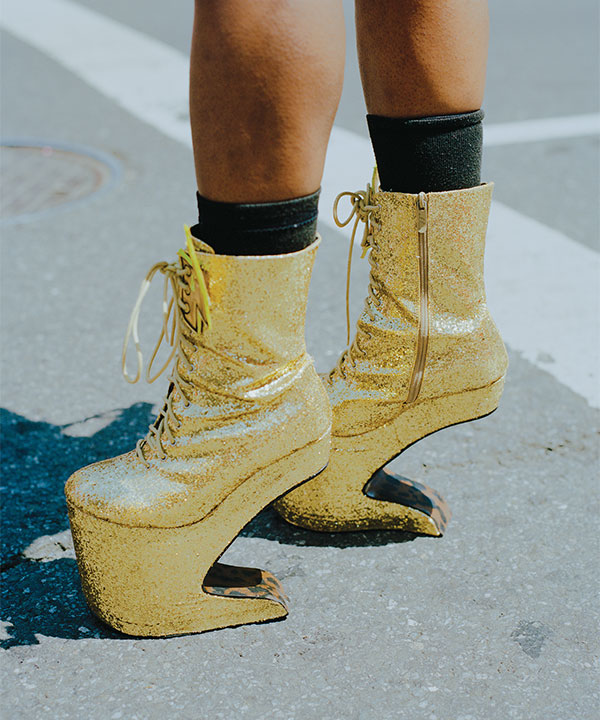
. . .
Behind the question of whether or not Pride has become overly commercialised is another, larger one: if many of the barriers that existed to LGBT equality in 1969 have since been overcome, at least in the west, what is the purpose of the event today at all? When I ask Michael Bronski, author of A Queer History of the United States (2011) and a professor of women and gender studies at Harvard, if corporate involvement is threatening to dilute the message of Pride, he points out that “it depends what you mean by ‘message’”.
Pride’s identity, he says, has undergone a gradual but significant shift over the past half-century. “These events really switched from an overtly political stand to one that is more inclusive of lots of people, more embracing of a broader ‘Pride’ agenda — meaning, to feel good about being gay, rather than demanding change.” What was once a “march”, he adds, is now, tellingly, more widely referred to as a “parade”. He argues that depoliticisation is inevitable as an event becomes mainstream. “The larger a movement gets, the more conservative it becomes, because its message gets watered down. If Black Lives Matter became really, really big, they’d be much less radical than they are now.”
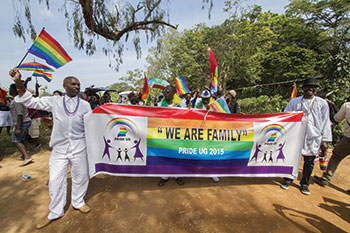
Elsewhere in the world, Pride remains radical; a necessary, and often brave, riposte to violence and oppression. Early this month, during a week of Pride events in Uganda, police raided a beauty pageant that featured transgender contestants. They arrested more than 16 people and, according to Human Rights Watch, “detained hundreds more for over 90 minutes, beating and humiliating people; taking pictures of lesbian, gay, bisexual, transgender, and intersex Ugandans and threatening to publish them”. One person jumped from a sixth-floor window to escape police violence.
Same-sex conduct remains punishable with jail time in Uganda under a colonial-era “anti-sodomy” provision; according to Maria Burnett, a senior researcher for the Africa division of Human Rights Watch, there has been “a significant escalation in vitriolic homophobic rhetoric from government officials over the past 10 years”. Isaac Mugisha, the co-ordinator of Pride Uganda, perseveres in running five days of events every year: as well as a lesbian and bisexual night and a beauty pageant, Pride also includes a visit to a local hospital, and the distribution of lubricants and condoms on the streets of Kampala.

The event has been running since 2012, and has not yet secured a sponsor. Mugisha offers an interesting perspective on the question of commercialisation: he tells me that the involvement of business would help to promote his cause, lending it visibility and legitimacy in the eyes of the rest of the population. “One of the things that is really most important is getting private companies supporting Pride,” he says. “That [would be] a huge achievement to us, because that would mean that the responsibility was shifting from ordinary individuals and becoming a national cause — that all Ugandans would look at this as a human rights struggle.”
In the US, although the gay rights movement has made great strides, there are still battles to be fought. Almost exactly a year after a Supreme Court ruling legalised gay marriage across the US, the nation suffered the deadliest attack on LGBT people in its history. On June 12, Omar Mateen shot and killed 49 people in a gay nightclub in Orlando, Florida. At the front of the New York Pride march two weeks later, the massacre was marked by 49 people wearing veils over their faces, each carrying a white sign bearing the name and date of birth of one of the victims.
At the Luminaries Brunch I meet Robert Pinter, a man in his sixties. “I get emotional just talking about it,” he says when we discuss the Orlando killings. “It resonates with every single LGBT person.” He points out that gay people continue to suffer violence in the US that often goes unreported. He gestures for me to feel his forearm, where there is a small solid ball under the skin — a bullet from a drive-by shooting that took place outside a gay bar in Milwaukee when he was a teenager. “You talk about terrorism,” he says. “To feel as a gay person every time you go on the street, if you’re identified as gay, you can be subject to some sort of violent attack by someone who’s a hateful person — it’s something that we’ve pretty much all been conditioned to deal with on a daily basis.”
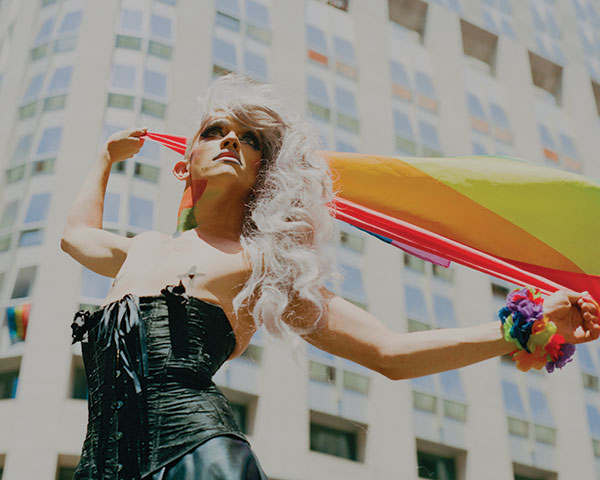
It is in this respect that Pride, even if its politics have been attenuated, remains powerful; it provides a safe and convivial space, free from fear and judgment, for individuals who may have suffered discrimination elsewhere. And in a consumer society, the presence of big, market-leading brands, including family names such as Disney, can provide part of that sense of support, as Isaac Mugisha pointed out. Beyond Pride, some corporations are taking active steps to effect change in laws concerning LGBT rights — this year, a number of brands, among them General Electric, Whole Foods and Pepsi, refused to do business with the state of North Carolina in response to the passing of the HB2 “bathroom bill”.
At the march, I spot a great plume of silver hair that erupts above the heads of the crowd. It belongs to Jessie Hatter, a slim, corseted drag queen whose spectacular height owes a debt to the towering red platform heels on which she is perched. Aged 24, she started doing drag two months ago, she tells me, and this is her first time at Pride. “My family’s not too accepting of what I do,” she says. Her mother hasn’t spoken to her since she started performing. “But it’s nice to know that I could build my own family.” She looks around at the masses. “Every single person in this parade, whether they know it or not, we’re all family.”

. . .
As Pride continues to evolve, it may be that the debate over its commercialisation proves, to a large extent, to be a generational one. “If you take people my age,” says Michael Bronski, who was 20 when the Stonewall riots took place, “down to people in their mid-forties, they grew up in a very different political atmosphere than younger people, who grew up with the notion that same-sex marriage might happen, that the Aids epidemic was over.” He points to the different expectations of millennials, who have grown up in a “commercialised culture” — one in which it is increasingly accepted that every aspect of life, both on- and offline, will be colonised by marketers.
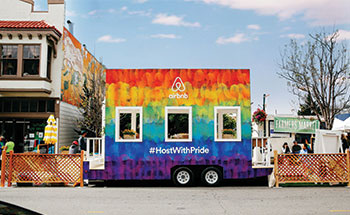
At the base of the Teaze pier, beside a double-decker Bud Light trailer, I meet one of Pride’s newest fans. Lila Luna, 23, is a student from California with cropped brown hair and baggy jeans who is in the city for the summer with two female friends. It’s their first time at this event, and they’re impressed. “This is so great,” says Luna, looking around at the dancing masses. “Events like this are super-important.”
I ask what she thinks of the idea that Pride has become too commercial — and that, in the process, it has lost some of its original message. “I’ve heard people saying that, and it’s bullshit!” she says sharply, pointing her beer at me. The friends, one of whom has taken the opportunity to cling on to my arm with her beer-free hand, nod in agreement. T-Mobile’s free “Mobilize for equality” rucksacks swing from their shoulders. “If Pride didn’t get commercial support,” concludes Luna, “it wouldn’t be as big. And we like it big!”

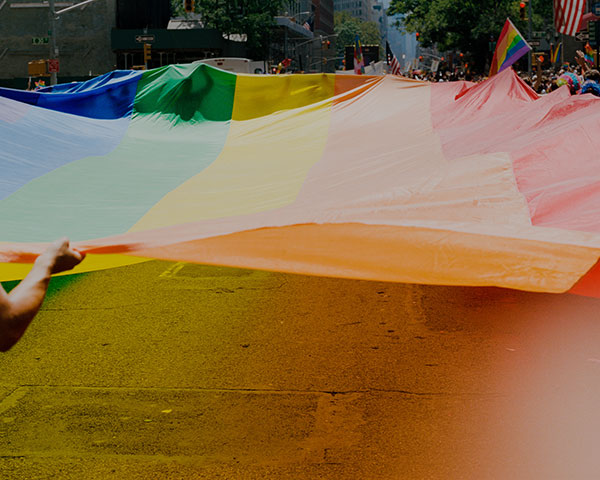
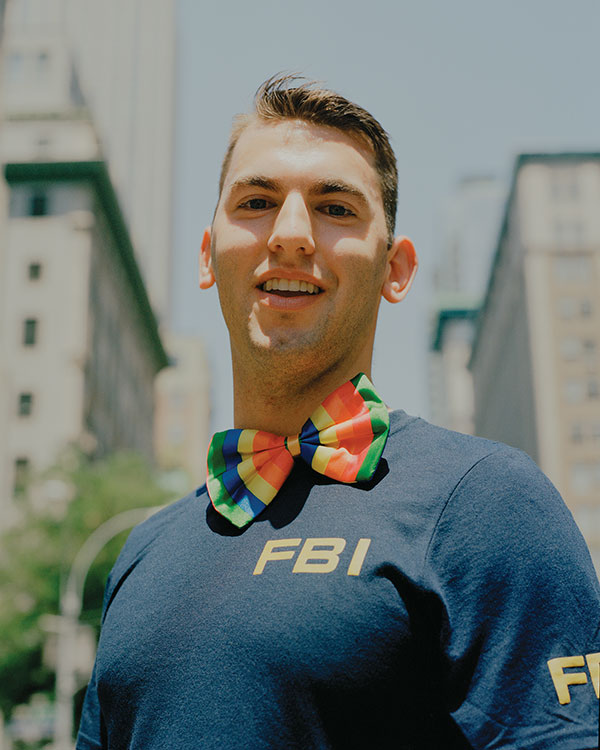
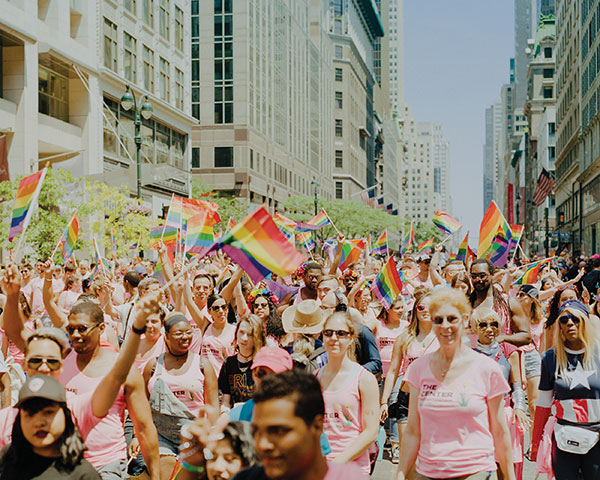
India Ross is an FT Weekend journalist
Photographs: Daniel Shea/Webber Represents; Isaac Kasamani/AFP/Getty Images; NY Daily News Archive via Getty Images; Fred W. McDarrah/Getty Images; Stuart Ramson/AP; Tiffany & Co/Peter Lindbergh; Airbnb
Comments